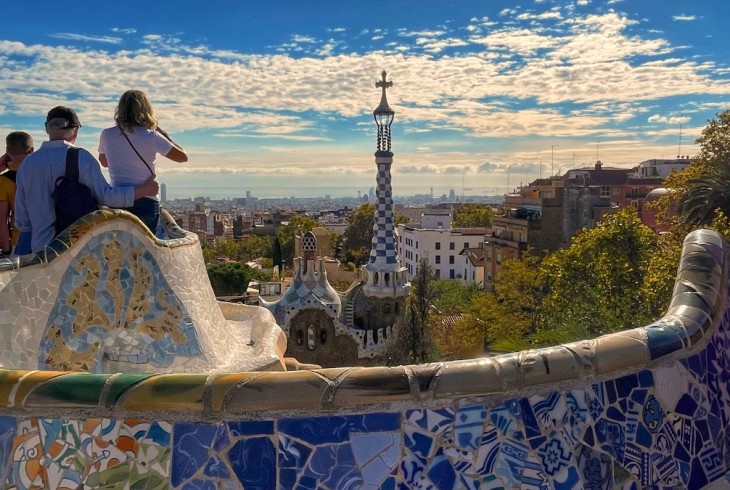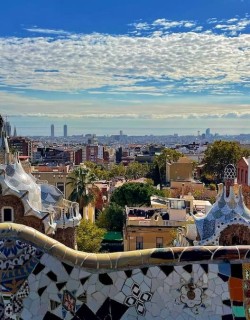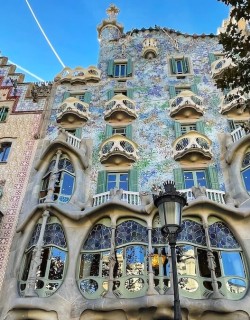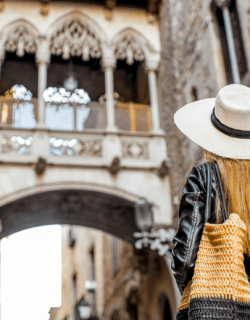The city of Barcelona is synonymous with the extraordinarily inventive architecture of Antoni Gaudí, and it's impossible to imagine the sun-kissed Catalan capital without his fantastical, dream-like creations. From the awe-inspiring Sagrada Familia church to jaw-dropping houses like Casa Batlo and La Pedrera, no visit to Barcelona is complete without delving into the mind of this great local master. But perhaps Gaudí's most-loved contribution to the city's environment is Park Güell, a vibrant, fairytale park located high on a hill overlooking downtown Barcelona as it sweeps down to the sea.
A Short History of Park Güell
Gaudí designed Park Güell at the behest of his greatest patron, the fabulously wealthy businessman Eusebi Güell, who wanted to create a beautiful, family-friendly residential district for Barcelona's well-heeled citizens. Güell was inspired by the leafy garden cities that were springing up all over Britain at this time, and turned to modernist master Gaudí to bring his vision to fruition.
Work began in 1900, and although construction progressed steadily, the project was abandoned in 1914 because Güell failed to drum up enough interest to sell the various plots of land for the proposed residences - ultimately, only two of the proposed 60 houses were over built. What had been constructed was turned into a large private park, and Güell often hosted public events here up until his death in 1918.
The park was opened to the public after it was sold to Barcelona's municipal authorities in 1926, and thanks to Gaudí's incredible architectural achievements it soon became one of the city's most popular sites for both locals and visitors alike. In 1984, Park Güell was awarded UNESCO World Heritage Status.
What to see at Park Güell
The Greek Theater and Serpentine Bench
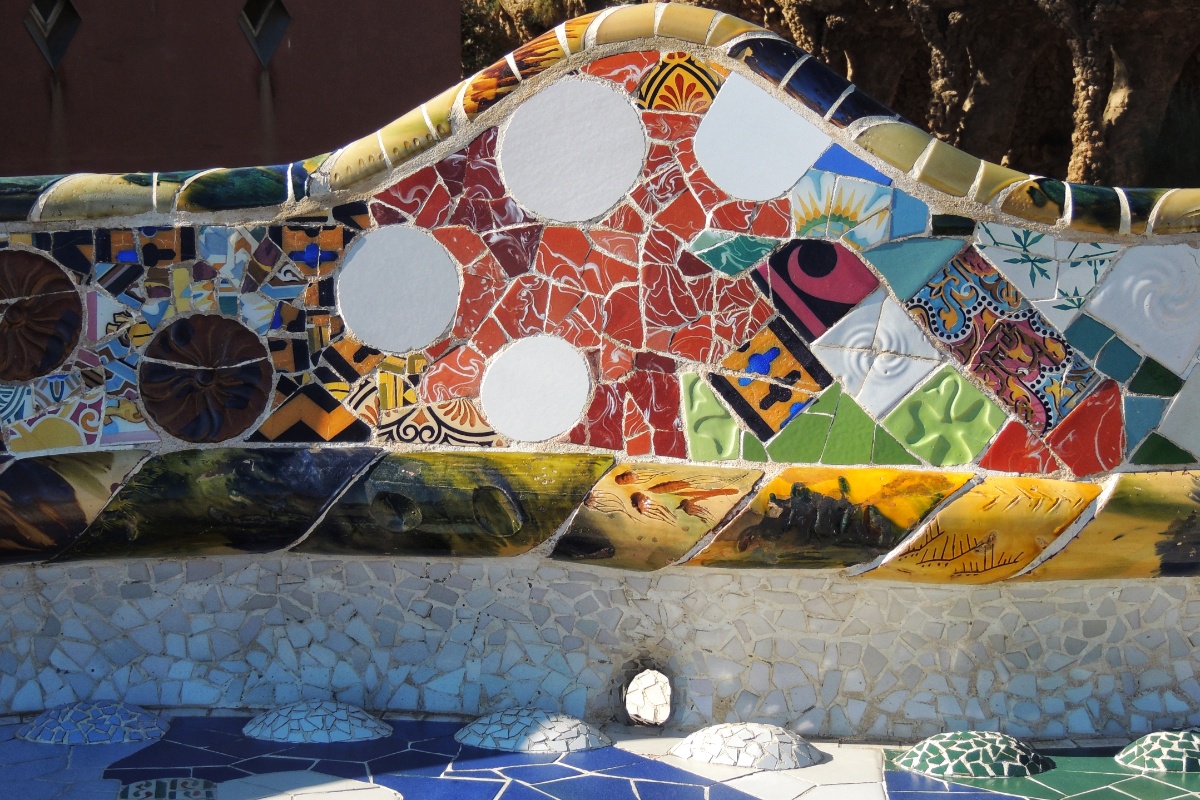
Snaking its way all around Park Güell's panoramic terrace - known both as La Plaça de la Natura and the Greek Theater - the Serpentine Bench is one of the most immediately recognizable features in the park. The undulating bench is a riot of color and seems to be almost alive as it unfolds in billowing curves around the large open space, providing respite for the visitors who come here.
The bench was created using a technique known as Trencadis, a method of designing mosaics pioneered by Gaudí himself that involves the fusing together of thousands of shards of broken ceramic tiles to compose innovative and colorful patterns. Gaudí deployed the trencadis technique for most of his major commissions in Barcelona, perhaps most spectacularly on the roof of La Pedrera across town. The tiles themselves were rejected from a nearby factory, and showcase Gaudí's long-standing interest in creative recycling and eco-friendly architectural practices, and the designs were made by Josep M. Jujol.

The sweeping esplanade itself is the spiritual heart of Park Güell, and was originally described as the Greek Theatre. The square was first designed to be the staging ground for al-fresco theatrical performances and shows, with the spectators watching from the adjacent terraces carved into the rocks of the surrounding hillside. The large, flat space is actually supported by the hypostyle room below, and the views from here, overlooking the gingerbread gatehouses below and extending all the way across Barcelona and to the glittering Mediterranean beyond, have to be seen to be believed.
The Dragon Staircase
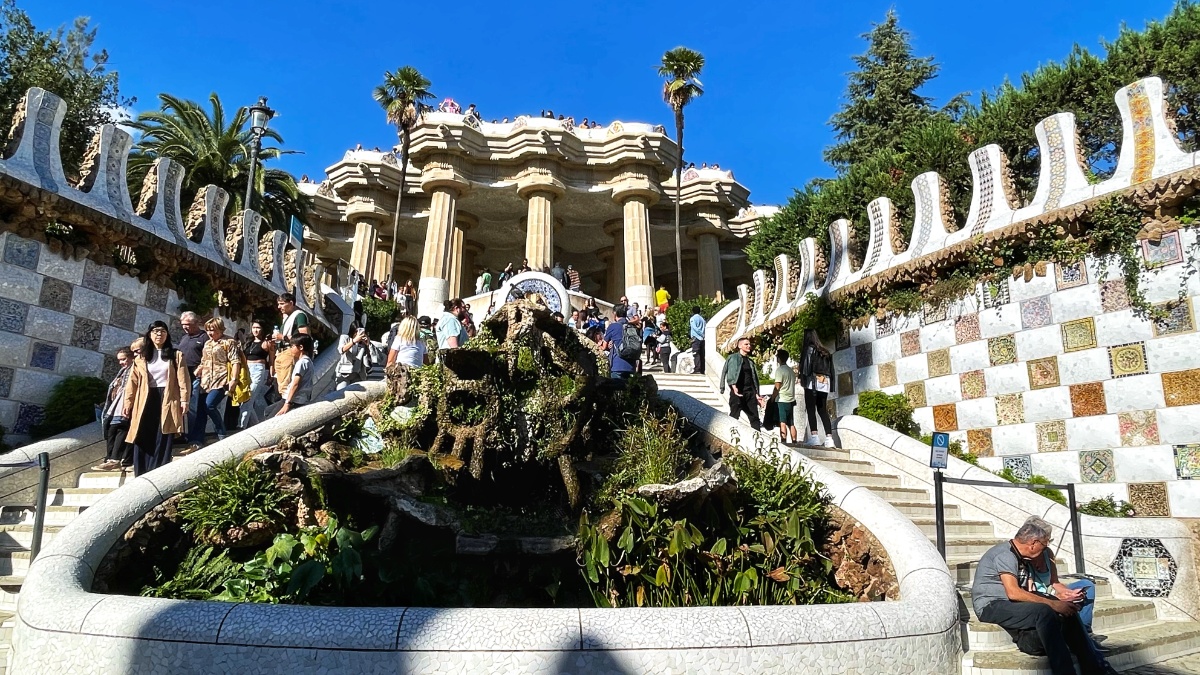
Another wonderful example of Gaudí's trencadis technique, the brightly-coloured, oversized mosaic salamander that stands guard on Park Güell's monumental Dragon staircase has become an iconic symbol of Barcelona. This curvaceous double stairway rises in four elegant flights of steps from the park's entrance esplanade up to the hypostyle, whose entrance is marked by imposing, chunky Doric columns.
Flanking the stairway are dramatic tiled crenellations, rising skywards like the spine of some prehistoric creatures, featuring more stunning mosaic decorations.
El Drac
One of Gaudí's best loved creations, 'El Drac' himself is 2.4 meters long and sports fabulous stripes made up of tiles in varying hues, from midnight blue to turquoise, orange and green. The symbolism of the sculpture is disputed: some argue that it an allegorical representation of fire, as salamanders are immune to flames, whilst others see a reference to Güell's hometown of Nimes.
If you look carefully, however, you'll find dragons and lizards popping up all over Barcelona. This is a reference to the life of the city's patron saint, George (or Jordi in Catalan), who slew a dragon threatening the well-being of a town in Cappadocia. A further reference to the fire-breathing creature can be found in the second of the stairway's three fountains, in which a dragon's head emerges from the flag of Catalonia.
The Hypostyle Room
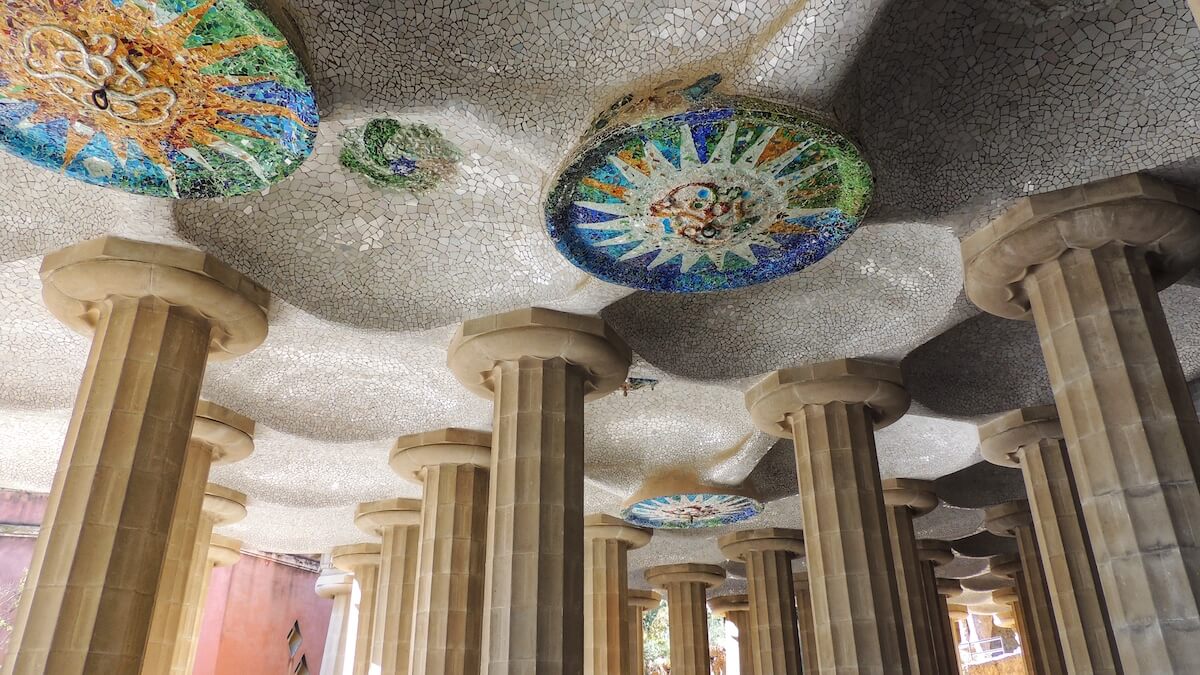
Hypostyle literally means 'under pillars' in Greek, and this covered space more than lives up to its name. A wonderfully ornamental ceiling is supported by no fewer than 86 fluted Doric columns, each over 6 meters tall and over a meter in diameter. The Sala Hipòstila was originally conceived of as a covered marketplace to service the needs of Park Güell's residents, although as the residential function of the estate never came to fruition the marketplace was ultimately not required.
The irregularly spaced and deliberately off-kilter columns inspire a feeling of movement in the visitor, and indeed the hypostyle room never seems to stand still. The magnificent ceiling is composed of a series of small domes made from clay bricks studded by circular Trencadis mosaics with abstract geometric designs created by Gaudí's collaborator Josep M. Jujol. Some of the medallions feature astrological symbols and representations of the seasons, whilst others are inspired by natural forms.
Porter's Lodge Pavilions
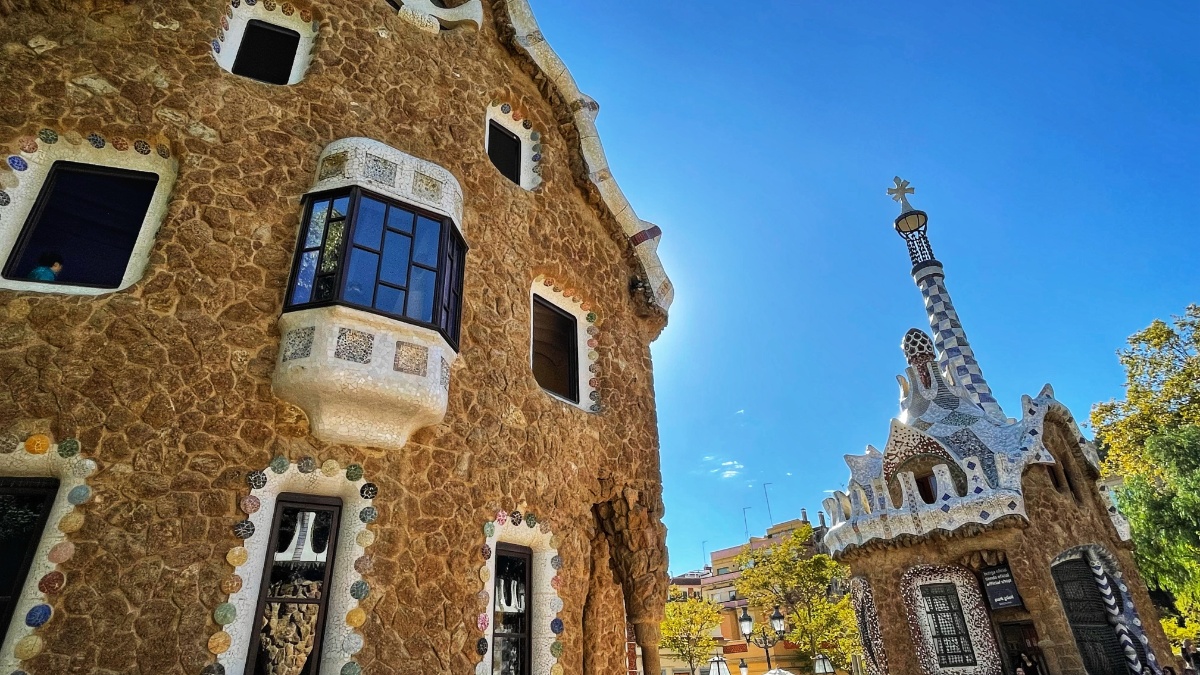
The iconic twin porter's lodge pavilions that flank the original main entrance to Park Güell seem to be taken straight from the pages of an elaborate fairytale. With their chunky proportions, brick facades and elaborate tiled roofs (once again enlivened with trencadis motifs), most visitors are immediately put in mind of gingerbread houses, and for good reason: an operatic version of the Brothers Grimm fairytale Hansel and Gretel was staged in Barcelona in the same year that work on Park Güell began, and the libretto was written by a friend of both Güell and Gaudí. Modern scholarship has convincingly argued that the architect was inspired by the play's descriptions of houses resembling cakes topped with sugar when designing the entrance pavilions.
The leftmost pavilion was originally the porter's lodge, complete with telephone booth and waiting room for visitors (now a souvenir shop), whilst the cottage on the right, known as the Casa del Garda, served as the porter's residence, and is now a small museum detailing the evolution of Park Güell. The panorama over the porter's lodge from the viewpoint on La Plaça de la Natura above is one of Barcelona's most memorable vistas.
The Viaducts and Laundry Room Portico
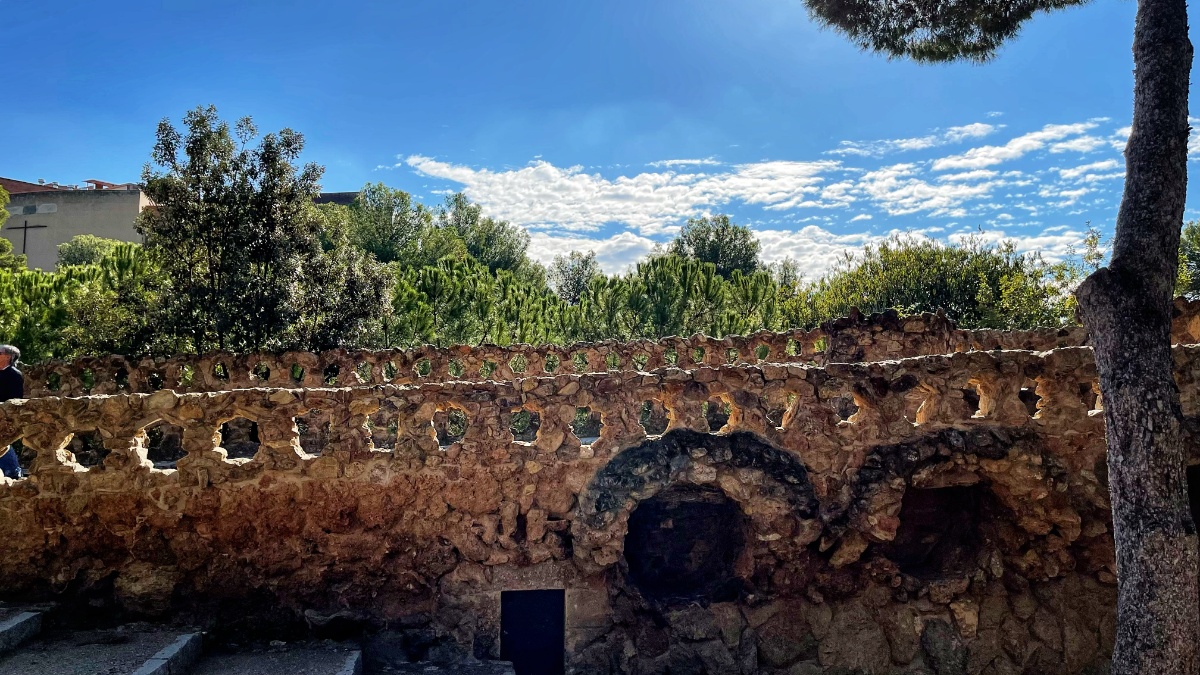
With its rough-hewn stone walls and vertiginous leaning columns, the laundry room portico seems to be more organic than man-made, a product of natural forces of erosion and weathering rather than the considered work of an architect. This was of course one of the guiding principles of Gaudí's approach to the built environment, which in his vision he had to always take nature as its supreme model.
The slanting walkway was designed by Gaudí to allusively evoke an ocean wave, and runs through a pine forest towards the gardens of the Casa Larrard, Güell's palatial former residence which was renovated by Gaudí in 1907 (it's now a school, which explains the happy chatter of children that you'll hear in this area of the park). The original purpose of the portico was multiple: it subtly connected the various residences of the development and supported a viaduct overhead, whilst also providing a shady spot to socialise protected from the fierce Mediterranean sun. Look out for the figure of a washerwoman carved into one of the stone columns - a modern re-imagining of the caryatids that supported the porticoes of ancient Greek temples.
Austria Gardens
Just to the right of the Hypostyle room is this leafy expansion, which was transformed into a plant nursery when Park Güell was taken over by the municipality of Barcelona in 1922. In the 1970s many thousands of trees were donated to the nursery by the Austrian State , prompting the name by which the garden is now known. No matter what time of the year you visit you'll be wowed by the sight of so many trees and flowers in bloom: look out for the spectacular creeping bougainvillaea!
Immersed in the greenery of the Austria Gardens is the Gaudí House Museum, where the architect himself lived between 1906 and 1925. Although designed in a Gaudí-esque modernista key, the building was actually the brainchild of architect Francesc d'Assís Berenguer I Mestres, and is one of only two residences built according to the original plan.
El Calvari
Located deep within the forested wildernesses of Park Güell above the monumental area, at 182 meters above sea level El Calvari is the highest point in the park. A devoutly religious man, Gaudí had intended to build a chapel on this spot, before settling on a miniature recreation of the site of Christ's Crucifixion at Calvary, marked with three crosses. To get here, follow the rough trails ever upwards: a magnificent view over Barcelona will be your reward.
Park Güell Tickets
Entrance to Park Güell is limited to a certain number of visitors each hour, so to avoid disappointment and skip the queues it's recommended that you book your timed entrance in advance via the official website . Tickets to the monumental area have increade to €18 for adults in 2025. A €13.50 reduced ticket is available for children from 7-12 years old and over 65s. Children under 7 go free, but still need to be included on your timed entrance. Entrance to the wider forest area is free, and does not need to be booked in advance. The Gaudí House Museum is accessed via a separate ticket. Alternatively, you can book a guided tour of Park Güell here.
How to get to Park Güell
Located in the elevated northern part of the city, the entrance to Park Güell is a 15-20 minute walk from the nearest metro station. Get off at the Lesseps stop on the Green Line 3, and follow the signs. Escalators up the hillside to the entrance on Avinguda del Santuari de Sant Josep de la Muntanya make the walk easier.
The H6 and D40 bus routes stop at Travessera de Dalt, a 10 minute walk from the entrance on Avinguda del Santuari de Sant Josep de la Muntaya.
When to Visit Park Güell
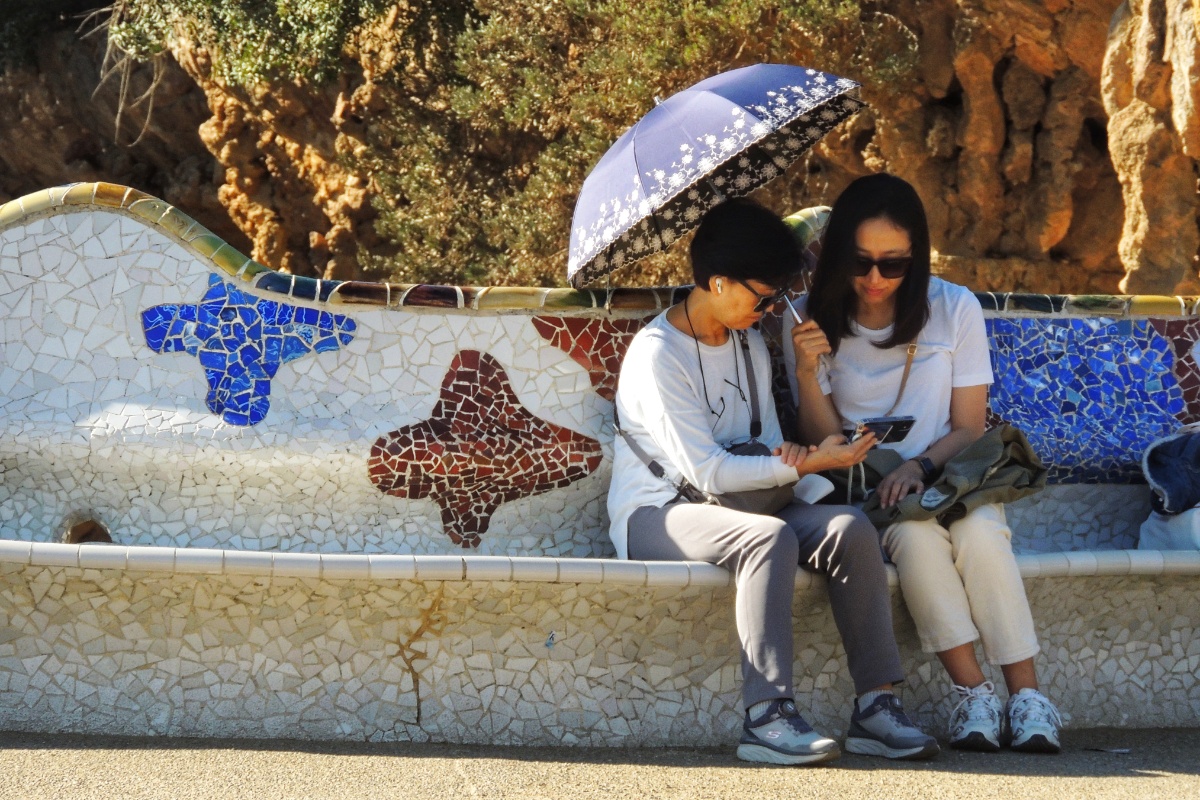
The park is open to the public from 9.30 AM to 6 PM in the winter months, and from 9.30 AM to 7.30 PM from late March. Whatever time of the year you're coming to Barcelona, the best times to visit Park Güell to avoid the worst of the crowds are on weekday mornings, shortly after the site opens at 9.30 am, or in the evening before closing time - when you 'll be able to drink in the spectacular sunset views. Weekends tend to be crowded.
We hope you enjoyed our illustrated guide to Park Güell! If you're planning a visit to Barcelona then make sure to book one of our specialist Gaudí tours , where you'll get to visit the Park Güell, Sagrada Familia and other masterpieces by the great artist in the company of a local expert.
